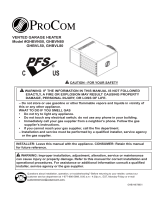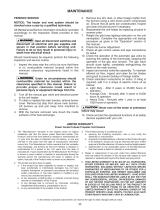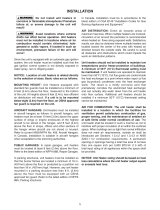
Commercial HVAC&R Division
Modine Manufacturing Company
1221 Magnolia Avenue
Buena Vista, Virginia 24416
Phone: 1.800.828.4328 (HEAT)
www.modine.com
11/05 - 3.5M Litho in USA
© Modine Manufacturing Company 2005
COMMERCIAL WARRANTY
Seller warrants its products to be free from defects in material and workmanship,
EXCLUSIVE, HOWEVER, of failures attributable to the use of materials substituted
under emergency conditions for materials normally employed. This warranty covers
replacement of any parts furnished from the factory of Seller, but does not cover
labor of any kind and materials not furnished by Seller, or any charges for any such
labor or materials, whether such labor, materials or charges thereon are due to
replacement of parts, adjustments, repairs, or any other work done. This warranty
does not apply to any equipment which shall have been repaired or altered outside
the factory of Seller in any way so as, in the judgment of Seller, to affect its stability,
nor which has been subjected to misuse, negligence, or operating conditions in
excess of those for which such equipment was designed. This warranty does not
cover the effects of physical or chemical properties of water or steam or other
liquids or gases used in the equipment.
BUYER AGREES THAT SELLER’S WARRANTY OF ITS PRODUCTS TO BE FREE
FROM DEFECT IN MATERIAL AND WORKMANSHIP, AS LIMITED HEREIN,
SHALL BE IN LIEU OF AND EXCLUSIVE OF ALL OTHER WARRANTIES,
EITHER EXPRESS OR IMPLIED, WHETHER ARISING FROM LAW, COURSE
OF DEALING, USAGE OF TRADE, OR OTHERWISE, THERE ARE NO OTHER
WARRANTIES, INCLUDING WARRANTY OF MERCHANTABILITY OR FITNESS
FOR PURPOSE, WHICH EXTEND BEYOND THE PRODUCT DESCRIPTION
CONFIRMED BY BUYER AND SELLER AS OF THE DATE OF FINAL
AGREEMENT.
This warranty is void if the input to the product exceeds the rated input as indicated
on the product serial plate by more than 5% on gas-fired and oil-fired units, or if the
product in the judgment of SELLER has been installed in a corrosive atmosphere,
or subjected to corrosive fluids or gases, been subjected to misuse, negligence,
accident, excessive thermal shock, excessive humidity, physical damage, impact,
abrasion, unauthorized alterations, or operation contrary to SELLER’S printed
instructions, or if the serial number has been altered, defaced or removed.
Heat Exchangers
For Seller’s non-separated combustion Gas-Fired Unit Heaters
BUYER’S REMEDY FOR BREACH OF WARRANTY, EXCLUSIVE OF ALL
OTHER REMEDIES PROVIDED BY LAW, IS LIMITED TO REPAIR OR
REPLACEMENT AT THE FACTORY OF SELLER, ANY HEAT EXCHANGER
WHICH SHALL, WITHIN TEN YEARS FROM DATE OF FIRST BENEFICIAL
USE BY BUYER OR ANY OTHER USER, WITHIN TEN YEARS FROM DATE
OF RESALE BY BUYER OR ANY OTHER USER, WITHIN TEN YEARS FROM
DATE OF RESALE BY BUYER IN ANY UNCHANGED CONDITION, OR
WITHIN ONE HUNDRED TWENTY-SIX MONTHS FROM DATE OF SHIPMENT
FROM SELLER, WHICHEVER OCCURS FIRST, BE RETURNED TO
SELLER WITH TRANSPORTATION CHARGES PREPAID AND WHICH THE
EXAMINATION OF SELLER SHALL DISCLOSE TO HAVE BEEN DEFECTIVE;
EXCEPT THAT WHEN THE PRODUCT IS TO BE USED BY BUYER AS
A COMPONENT PART OF EQUIPMENT MANUFACTURED BY BUYER,
BUYER’S REMEDY FOR BREACH, AS LIMITED HEREIN, SHALL BE LIMITED
TO ONE YEAR FROM DATE OF SHIPMENT FROM SELLER. FOR GAS-
FIRED PRODUCTS INSTALLED IN HIGH HUMIDITY APPLICATIONS AND
UTILIZING STAINLESS STEEL HEAT EXCHANGERS, BUYER’S REMEDY
FOR BREACH, AS LIMITED HEREIN, SHALL BE LIMITED TO TEN YEARS
FROM DATE OF SHIPMENT FROM SELLER.
For Seller's Low Intensity Gas-Fired Infrared Heaters
BUYER'S REMEDY FOR BREACH OF WARRANTY, EXCLUSIVE OF ALL
OTHER REMEDIES PROVIDED BY LAW, IS LIMITED TO REPAIR OR
REPLACEMENT AT THE FACTORY OF SELLER, ANY HEAT EXCHANGER
WHICH SHALL, WITHIN FIVE YEARS FROM DATE OF FIRST BENEFICIAL
USE BY BUYER OR ANY OTHER USER, WITHIN FIVE YEARS FROM
DATE OF RESALE BY BUYER OR ANY OTHER USER, WITHIN FIVE
YEARS FROM DATE OF RESALE BY BUYER IN ANY UNCHANGED
CONDITION, OR WITHIN 66 MONTHS FROM DATE OF SHIPMENT FROM
SELLER, WHICHEVER OCCURS FIRST, BE RETURNED TO SELLER WITH
TRANSPORTATION CHARGES PREPAID AND WHICH THE EXAMINATION
OF SELLER SHALL DISCLOSE TO HAVE BEEN DEFECTIVE; EXCEPT THAT
WHEN THE PRODUCT IS TO BE USED BY BUYER AS A COMPONENT
PART OF EQUIPMENT MANUFACTURED BY BUYER, BUYER'S REMEDY
FOR BREACH, AS LIMITED HEREIN, SHALL BE LIMITED TO ONE YEAR
FROM DATE OF SHIPMENT FROM SELLER.
Heat Exchanger (Condensers) for all Seller’s products except non-
separated combustion Gas-Fired Unit Heaters and Infrared Heaters, all
Burners except Infrared Heaters, and Sheet Metal for all Seller's products
BUYER’S REMEDY FOR BREACH OF WARRANTY, EXCLUSIVE OF ALL
OTHER REMEDIES PROVIDED BY LAW, IS LIMITED TO REPAIR OR
REPLACEMENT AT THE FACTORY OF SELLER, ANY HEAT EXCHANGER
(CONDENSER) OR BURNER WHICH SHALL, WITHIN ONE YEAR
FROM DATE OF FIRST BENEFICIAL USE BY BUYER OR ANY OTHER
USER, WITHIN ONE YEAR FROM DATE OF RESALE BY BUYER IN ANY
UNCHANGED CONDITION, OR WITHIN EIGHTEEN MONTHS FROM
DATE OF SHIPMENT FROM SELLER, WHICHEVER OCCURS FIRST, BE
RETURNED TO SELLER WITH TRANSPORTATION CHARGES PREPAID
AND WHICH THE EXAMINATION OF SELLER SHALL DISCLOSE TO HAVE
BEEN DEFECTIVE; EXCEPT THAT WHEN THE PRODUCT IS TO BE USED
BY BUYER AS A COMPONENT PART OF EQUIPMENT MANUFACTURED BY
BUYER, BUYER’S REMEDY FOR BREACH, AS LIMITED HEREIN, SHALL BE
LIMITED TO ONE YEAR FROM DATE OF SHIPMENT FROM SELLER.
Burners
For Seller's Low Intensity Gas-Fired Infrared Heaters
BUYER'S REMEDY FOR BREACH OF WARRANTY, EXCLUSIVE OF ALL
OTHER REMEDIES PROVIDED BY LAW, IS LIMITED TO REPAIR OR
REPLACEMENT AT THE FACTORY OF SELLER, ANY BURNER WHICH
SHALL, WITHIN TWO YEARS FROM DATE OF FIRST BENEFICIAL USE
BY BUYER OR ANY OTHER USER, WITHIN TWO YEARS FROM DATE
OF RESALE BY BUYER IN ANY UNCHANGED CONDITION, OR WITHIN
30 MONTHS FROM DATE OF SHIPMENT FROM SELLER, WHICHEVER
OCCURS FIRST, BE RETURNED TO SELLER WITH TRANSPORTATION
CHARGES PREPAID AND WHICH THE EXAMINATION OF SELLER
SHALL DISCLOSE TO HAVE BEEN DEFECTIVE; EXCEPT THAT WHEN
THE PRODUCT IS TO BE USED BY BUYER AS A COMPONENT PART
OF EQUIPMENT MANUFACTURED BY BUYER, BUYER'S REMEDY FOR
BREACH, AS LIMITED HEREIN, SHALL BE LIMITED TO ONE YEAR FROM
DATE OF SHIPMENT FROM SELLER.
For Seller's High Intensity Gas-Fired Infrared Heaters
BUYER'S REMEDY FOR BREACH OF WARRANTY, EXCLUSIVE OF ALL
OTHER REMEDIES PROVIDED BY LAW, IS LIMITED TO REPAIR OR
REPLACEMENT AT THE FACTORY OF SELLER, ANY BURNER WHICH
SHALL, WITHIN TEN YEARS FROM DATE OF FIRST BENEFICIAL USE
BY BUYER OR ANY OTHER USER, WITHIN TEN YEARS FROM DATE
OF RESALE BY BUYER IN ANY UNCHANGED CONDITION, OR WITHIN
126 MONTHS FROM DATE OF SHIPMENT FROM SELLER, WHICHEVER
OCCURS FIRST, BE RETURNED TO SELLER WITH TRANSPORTATION
CHARGES PREPAID AND WHICH THE EXAMINATION OF SELLER
SHALL DISCLOSE TO HAVE BEEN DEFECTIVE; EXCEPT THAT WHEN
THE PRODUCT IS TO BE USED BY BUYER AS A COMPONENT PART
OF EQUIPMENT MANUFACTURED BY BUYER, BUYER'S REMEDY FOR
BREACH, AS LIMITED HEREIN, SHALL BE LIMITED TO ONE YEAR FROM
DATE OF SHIPMENT FROM SELLER.
All Other Components Excluding Heat Exchanger (Condenser), Burner,
and Sheet Metal
For all Seller's products except Direct-Fired Heaters and High Intensity
Gas-Fired Infrared Heaters
BUYER’S REMEDY FOR BREACH OF WARRANTY, EXCLUSIVE OF ALL
OTHER REMEDIES PROVIDED BY LAW, IS LIMITED TO REPAIR OR
REPLACEMENT AT THE FACTORY OF SELLER, ANY PART OR PARTS
WHICH SHALL, WITHIN TWO YEARS FROM DATE OF FIRST BENEFICIAL
USE BY BUYER OR ANY OTHER USER, WITHIN TWO YEARS FROM DATE
OF RESALE BY BUYER IN ANY UNCHANGED CONDITION, OR WITHIN
THIRTY MONTHS FROM DATE OF SHIPMENT FROM SELLER, WHICHEVER
OCCURS FIRST, BE RETURNED TO SELLER WITH TRANSPORTATION
CHARGES PREPAID AND WHICH THE EXAMINATION OF SELLER
SHALL DISCLOSE TO HAVE BEEN DEFECTIVE; EXCEPT THAT WHEN
THE PRODUCT IS TO BE USED BY BUYER AS A COMPONENT PART
OF EQUIPMENT MANUFACTURED BY BUYER, BUYER’S REMEDY FOR
BREACH, AS LIMITED HEREIN, SHALL BE LIMITED TO ONE YEAR FROM
DATE OF SHIPMENT FROM SELLER.
For Seller's Direct-Fired Heaters and High Intensity Gas-Fired Infrared Heaters
BUYER’S REMEDY FOR BREACH OF WARRANTY EXCLUSIVE OF
ALL OTHER REMEDIES PROVIDED BY LAW IS LIMITED TO REPAIR
OR REPLACEMENT AT THE SELLER’S OPTION ANY PART OR PARTS
WHICH SHALL WITHIN A PERIOD OF ONE YEAR FROM DATE OF FIRST
BENEFICIAL USE BY BUYER OR ANY OTHER USER, WITHIN ONE YEAR
FROM DATE OF RESALE BY BUYER IN ANY UNCHANGED CONDITION,
OR WITHIN 18 MONTHS FROM DATE OF SHIPMENT FROM SELLER,
WHICHEVER OCCURS FIRST, BE RETURNED TO SELLER WITH
TRANSPORTATION CHARGES PREPAID AND WHICH THE EXAMINATION
OF THE SELLER SHALL DISCLOSE TO HAVE BEEN DEFECTIVE.
BUYER AGREES THAT IN NO EVENT WILL SELLER BE LIABLE FOR COSTS
OF PROCESSING, LOST PROFITS, INJURY TO GOODWILL, OR ANY OTHER
CONSEQUENTIAL OR INCIDENTAL DAMAGES OF ANY KIND RESULTING
FROM THE ORDER OR USE OF ITS PRODUCT, WHETHER ARISING FROM
BREACH OF WARRANTY, NONCONFORMITY TO ORDERED SPECIFICATIONS,
DELAY IN DELIVERY, OR ANY LOSS SUSTAINED BY THE BUYER.
Modine Manufacturing Company has a continuous product improvement program;
it reserves the right to change design and specifications without notice.
• FOR RESIDENTIAL USE SEE LIMITED CONSUMER WARRANTY ON PREVIOUS PAGE.






















